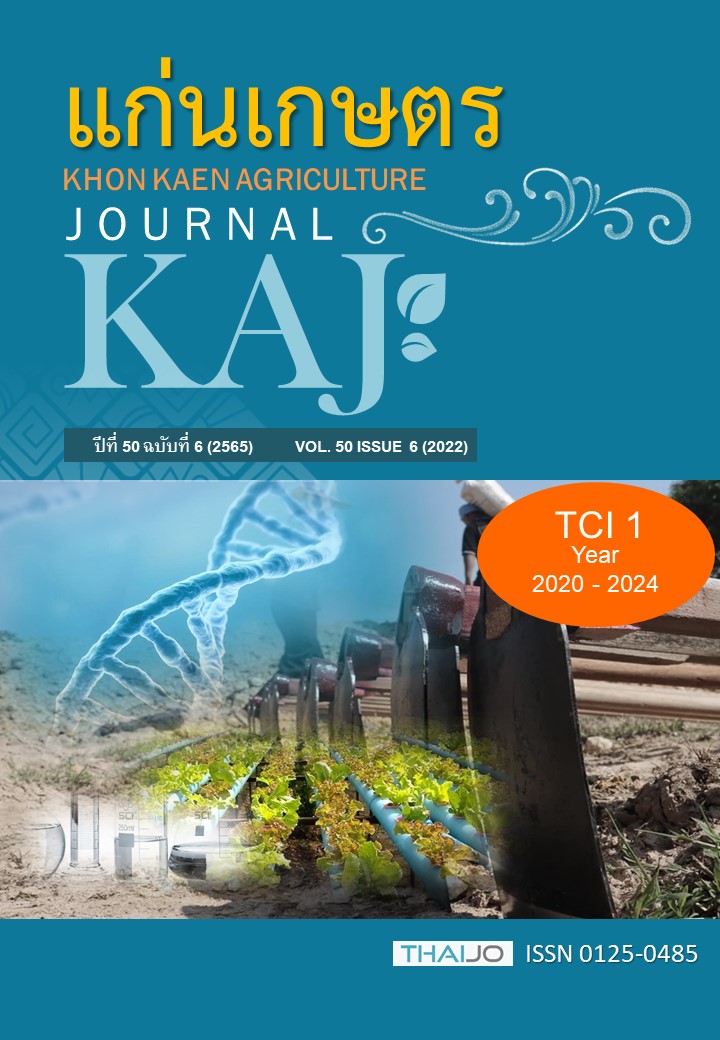ผลผลิต ปริมาณแป้งและผลตอบแทนทางเศรษฐศาสตร์ของพันธุ์มันสำปะหลังที่ปลูกหลังข้าวในนาน้ำฝนจังหวัดมหาสารคาม
Main Article Content
บทคัดย่อ
การปลูกมันสำปะหลังในนาหลังข้าว เป็นแนวทางหนึ่งในการเพิ่มประสิทธิภาพการใช้ที่ดินและรายได้ของเกษตรกรผู้ปลูกข้าวในนาพึ่งพาน้ำฝนเป็นหลัก วัตถุประสงค์ของงานวิจัยนี้เพื่อทดสอบเปรียบเทียบผลผลิต ปริมาณแป้ง และผลตอบแทนของมันสำปะหลังที่ปลูกในนาหลังเก็บเกี่ยวข้าวในสภาพนาลุ่มและนาดอน คือพันธุ์ระยอง 7 ระยอง 72 เกษตรศาสตร์ 50 และ CMR 33-38-48 ใช้แผนการทดลอง randomized complete block design (RCBD) จำนวน 4 ซ้ำ ทำการทดลองที่แปลงนาเกษตรกร บ้านโคกกลาง ตำบลบรบือ อำเภอบรบือ จังหวัดมหาสารคาม ระหว่างเดือนธันวาคม 2560 ถึงเดือน พฤษภาคม 2561 ผลการศึกษาพบว่า มันสำปะหลังพันธุ์ ระยอง 7 ให้ผลผลิตและผลตอบแทนทางเศรษฐศาสตร์ในนาลุ่มสูงสุดจึงควรแนะนำส่งเสริมให้เกษตรกรปลูกในนาลุ่ม พันธุ์เกษตรศาสตร์50 ให้ผลผลิตและผลตอบแทนทางเศรษฐศาสตร์ในนาดอนสูงสุดจึงควรแนะนำส่งเสริมให้เกษตรกรปลูกในนาดอน ส่วนพันธุ์ CMR 33-38-48 ที่ได้รับการปรับปรุงพันธุ์อายุสั้นยังให้ผลผลิตและผลตอบแทนต่ำกว่าพันธุ์เดิมที่มีอายุเก็บเกี่ยวยาวบางพันธุ์ จึงสมควรมีการพัฒนาปรับปรุงพันธุ์ที่มีอายุสั้นที่เหมาะสมเพื่อปลูกในนาลุ่มหลังเก็บเกี่ยวข้าวต่อไป อย่างไรก็ตาม การปลูกมันสำปะหลังในนาหลัง เก็บเกี่ยวข้าวทำให้เกษตรกรมีรายได้ ในช่วงฤดูแล้งก่อนที่จะใช้พื้นที่นาปลูกข้าวในช่วงฤดูฝนถัดไปในรอบปี
Article Details

อนุญาตภายใต้เงื่อนไข Creative Commons Attribution-NonCommercial-NoDerivatives 4.0 International License.
เอกสารอ้างอิง
กรมวิชาการเกษตร. 2564. คำแนะนำการใช้ปุ๋ยตามค่าวิเคราะห์ดินสำหรับพืชไร่เศรษฐกิจ. กองวิจัยพัฒนาปัจจัยการผลิตทางการเกษตร กรมวิชาการเกษตร กระทรวงเกษตรและสหกรณ์. กรุงเทพฯ.
วิไล สันติโสภาศรี, กาญจนา กู้โรจนวงศ์ และกล้าณรงค์ ศรีรอต. 2541. การเปลี่ยนแปลงองค์ประกอบทางชีวเคมีในหัวมันสำปะหลังเปรียบเทียบพันธุ์และอายุการเก็บเกี่ยว. น. 246. ใน: ประชุมทางวิชาการของมหาวิทยาลัยเกษตรศาสตร์ ครั้งที่ 36: บทคัดย่อ 3-5 กุมภาพันธ์ 2541. มหาวิทยาลัยเกษตรศาสตร์, กรุงเทพฯ.
สุวลักษณ์ อะมะวัลย์. 2555. ผลของปุ๋ยชีวภาพพีจีพีอาร์ต่อการเพิ่มประสิทธิภาพการผลิตของมันสำปะหลัง. การศึกษาอิสระปริญญาวิทยาศาสตรมหาบัณฑิต สาขาวิชาการจัดการสิ่งแวดล้อม คณะพัฒนาสังคมและสิ่งแวดล้อม สถาบันบัณฑิตพัฒนบริหารศาสตร์.
สำนักงานเศรษฐกิจการเกษตร. 2562. ข้อมูลการใช้เนื้อที่ประโยชน์ทางการเกษตร 2562. แหล่งข้อมูล: https://www.oae.go.th/view/1/การใช้ที่ดิน/TH-TH. ค้นเมื่อ 27 มกราคม 2565.
สำนักงานเศรษฐกิจการเกษตร. 2563. ข้อมูลการผลิตสินค้าเกษตร 2563. แหล่งข้อมูล: http://www.oae.go.th/ewt_news.php?nid=13577. ค้นเมื่อ 2 พฤษภาคม 2564.
Bainbridge, Z., K. Tomlins., K. Willings, and A. Westby. 1996. Methods for assessing quality characteristics of non grain starch staple. Part 4 advanced methods. UK: University of Greenwich.
El-Sharkawy, M.A. 2007. Physiological characteristics of cassava tolerance to prolong drought in the tropics: Implication for breeding cultivars adapted to seasonally dry and semiarid environments. Brazilian Journal of Plant Physiology. 19: 257-286.
El-Sharkawy, M.A. 2003. Cassava biology and physiology. Plant Molecular Biology. 53: 621-641.
Food and Agriculture Organization. 2001. The global cassava development strategy and implementation plan. Proc. Validation Forum on the Global Cassava Development Strategy. 1: 13-15.
Fukai, S., and M. Ouk. 2012. Increased productivity of rainfed lowland rice cropping systems of Mekong region. Crop and Pasture Science. 63: 944-973.
Gonzalez, L., and M. Gonzalez–Vilar. 2001. Determination of relative water content. In M. J. R. Roger (Ed.), Handbook of plant ecophysiology techniques (pp. 207–212). Dordrecht, the Netherlands: Kluwer Academic Publishers.
Kittipadakul, P., E. Sarobol., V. Vichukit., P. Duangpatra., J. Rojanaritphichet, and S. Rungmekarat. 2013. 52 Days of Cassava Technology. Available: http://www.52subda. Com/publications/index?crop_id=1 (in Thai). Retrieved December 13, 2017.
Lantican, R.M. 1982. Field crop breeding for multiple cropping patterns. IRRI, Los Banos, Philippines: Cropping Systems Research and Development for the Asia Rice Farmer. IRRI, Los Banos Philippines.
Mckey, D., T.R. Cavagaro., J. Cliff, and R. Gleadow. 2010. Chemical ecology in coupled human and natural systems. Chemoecology. 20: 109-133.
Panyangnoi, K., Y. Supama, S. Chanyakon, and P. Pangjan. 2013. Test on cropping systems in paddy rainfed area in Khon Kaen Province. Nakhon Phanom University J. 12 (8 th Natural conference of agricultural): 161-167. (in Thai).
Polthanee, A., C. Janthajam, and A. Promkhambut. 2014a. Growth, yield and starch content of cassava following rainfed lowland rice in Northeast Thailand. International Journal of Agricultural Research. 9(6): 319-324.
Polthanee, A., and A. Promkhambut. 2014. Impact of climate change on rice-based cropping system and farmers’ adaptation strategies in Northeast Thailand. Asian Journal of Crop Science. 6(3): doi: 10.3923/ajcs.2014.
Sawatraksa, N., P. Banterng, S. Jogloy, N. Vorasoot, and G. Hoogenboom. 2018. Chlorophyll fluorescence and biomass of four cassava genotypes grown under rain-fed upper paddy field conditions in the tropics. Journal of Agronomy and Crop Science. 204:554– 565.
Smart, R., and G.E. Bingham. 1974. Rapid estimates of relative water content. Plant Physiology. 53: 258-260.
Suja, G., K. John, I. Sreekumar, and J. Srinivar. 2010. Short-duration cassava genotypes for crops diversification in the humid tropics: growth dynamics, biomass, yield and quality. Journal of the Science of Food and Agriculture. 90: 188-198.
Tsubo, M., J. Basnayake, S. Fukai, V. Sihathep., P. Siyavong, and M. champhengsay. 2006. Toposequential effects on water balance and productivity in rainfed lowland rice ecosystem. Field Crops Research. 97: 209-220.
Unnikrishnan, M., S.G. Nair, C.R. Mohankumar, and M. Anantharaman. 2001. Evaluation of two early maturing cassava lines. Central Tuber Crops Research Institute. 27: 29-34.
Vandegear, R., R.E. Miller, M. Brain, R.M. Gleadow, and T.R. Cavagnaro. 2013. Drought adversely affects tuber development and nutritional quality of staple crop cassava. Functional Plant Biology. 40: 195-200.
Varma S.P., and P. Pranothkumar. 1996. Evaluation of short duration lines of cassava. pp. 238-240. In: Tropical Tuber Crops: Problems, Prospects and Future Strategies, (Kurup, G.T., Palaniswami M.S., Potty V.P., Padmaja G, Kabeerathumma S. and Pillai, S.V. eds.). Central Tuber Crops Research Institute, Thiruvananthapuram.
Zandstra, H.G. 1982. Effect of soil moisture on the growth of upland crops after wetland rice: Cropping Systems Research in Asia. IRRI, Los Banos Philippines.


